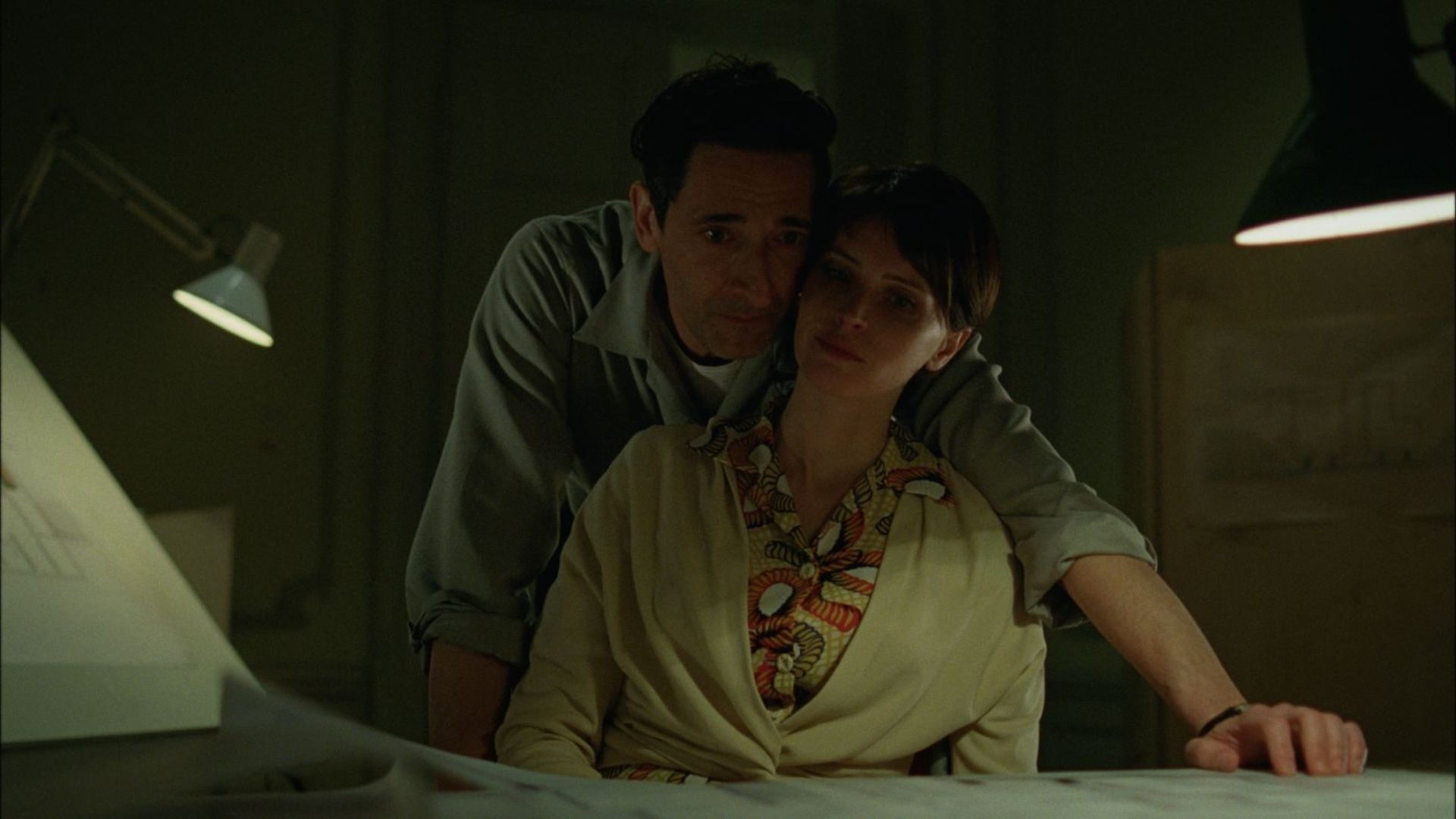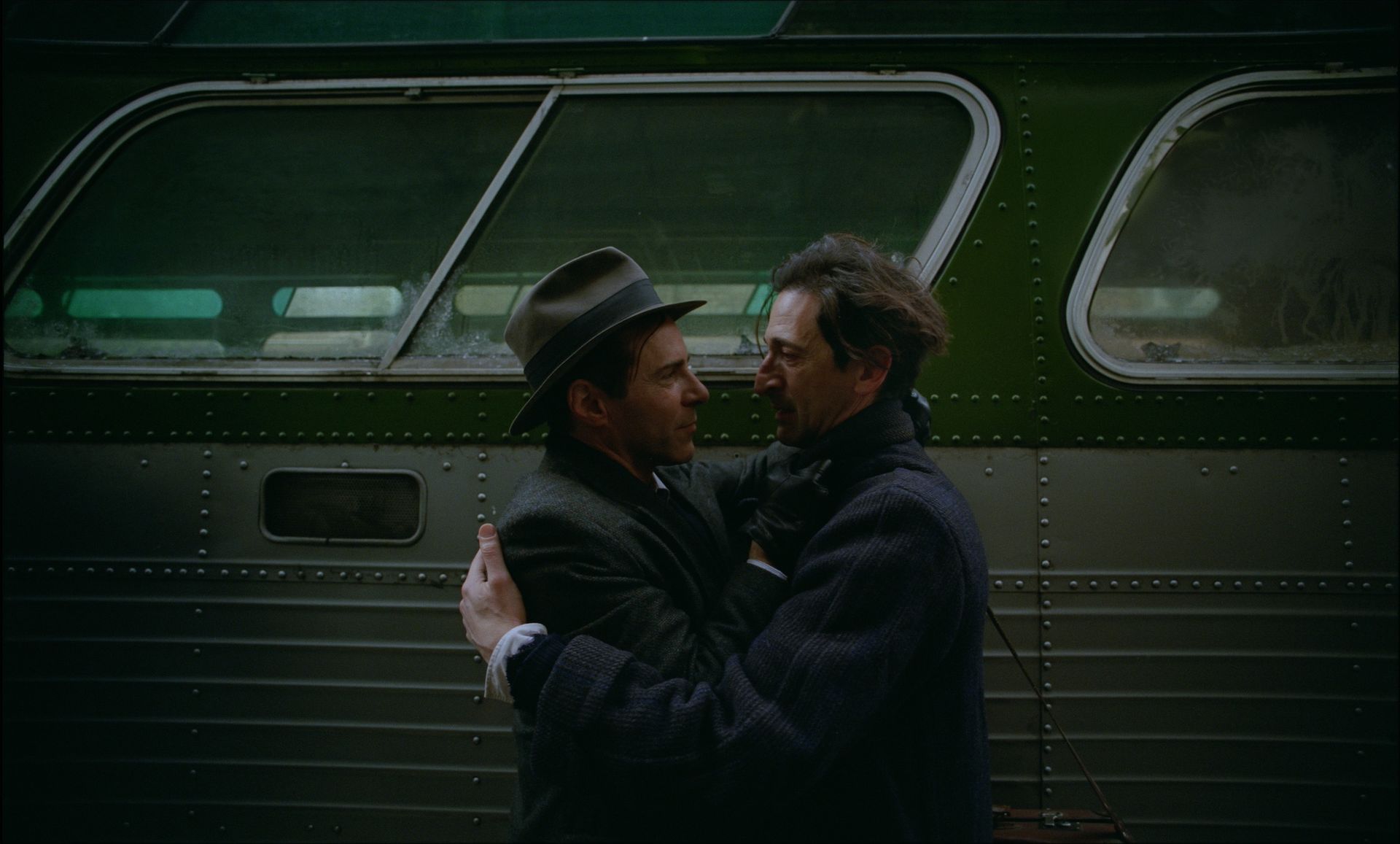Some of the most beautiful buildings in the United States are suburban synagogues. In the decades following the Holocaust, a time of significant Jewish migration to the US and significant white migration to suburbia, Jewish congregations heralded their arrival by commissioning architects such as the Prussia-born Erich Mendelsohn, a one-time associate of Ludwig Mies van Der Rohe and Walter Gropius, to design the temples that would inscribe the intertwined religious and secular histories of old-world Jewry and European modernism on the built environment of the American century.
It is not a synagogue that the architect Lászlo Tóth (Adrien Brody) spends much of The Brutalist building—in fact, it is a community centre that includes a Protestant chapel—but its high-vaulted concrete ceilings are nevertheless a startlingly alien intervention in Doylestown, Pennsylvania, an outsider’s contested proclamation of arrival. Tóth’s struggles to realise his grand design, and to make his home in Bucks County, speak to the mingled fascination and mistrust with which radical aesthetics and foreign traditions are conditionally welcomed into the US.
Brady Corbet’s film introduces Tóth as his ship arrives in New York City in 1947, the camera carried along by the huddled masses in a Steadicam shot landing on an upside-down view of the Statue of Liberty—a composition to foreshadow the film’s ironic view of the melting-pot myth and interest in the altered perspectives of modernism. Tóth is soon settled in the back room of a Philadelphia furniture store owned by his cousin (Alessandro Nivola), whose Catholic wife offers help in getting his nose fixed. Tóth’s first design for the store, an office chair and desk sharing a frame fashioned from a single sleek, sinuous piece of metal, is a metallic flash of the future amid the dark wood of the store’s staid Craftsman-era offerings. When he lands a chance commission to redesign the library of Harrison Van Buren (Guy Pearce), the shock of the new is initially too much for the Doylestown industrialist. Van Buren (based in part, Corbet has said, on the chemist and art collector Albert C. Barnes) hates the library, with its Minimalist furnishings and functional built-ins—until, that is, he finds out that it was designed by a refugee who won renown in Europe and trained at the Bauhaus. Van Buren likes Tóth’s pedigree more than he understands his work, but he becomes his patron as the two embark on the community centre project together, a difficult process marked by arguments over money and creative control, and coloured by a rich man’s admiration, envy, suspicion and possessiveness of his court artist and pet ethnic Other.

A scene from The Brutalist Courtesy of A24
At 215 minutes including a built-in intermission, The Brutalist is heavy with the weight of the years, which roll by as Tóth’s wife Erzsébet (Felicity Jones) and largely mute niece Zsófia (Raffey Cassidy) languish in displaced-persons limbo. This background plot snaps into focus at the halfway point: throughout the intermission, a recovered family photograph crucial to their visa application stays onscreen, accompanied by a 15-minute countdown clock, a haunting reminder of Jewish life in prewar eastern Europe that will be mirrored, in the film’s second half, with Zsófia’s growing curiosity about the newly formed state of Israel.
Classical in its construction and avant-garde in its often hazy and dissonant storytelling (as well as in a score by Daniel Blumberg which apes the work of Corbet’s late former collaborator Scott Walker, to whom the film is dedicated), the film is the first since 1961to be shot using the VistaVision widescreen format. The Brutalist has an eye on posterity, as confirmed by the decision of Corbet and his producers to strike 70mm prints for the film’s festival-season rollout. (Corbet won the Silver Lion, the directing prize, at this year’s Venice International Film Festival.) Obvious points of comparison are Paul Thomas Anderson’s at once burrowing and expansive historical canvases, though The Brutalist is more like The Master, a master-servant two-hander with a hard-to-pin down allegory, than There Will Be Blood, a star-driven epic of manifest destiny—Brody is a far more prickly and recessive great man of history than Daniel Day-Lewis, and Tóth’s natural arrogance is often submerged by circumstances.
Corbet, who writes his films with his wife, the Norwegian film-maker Mona Fastvold, is interested in power and spectacle—whether the frozen spectacle of a building, the crowds and mass political movements of his proof-of-concept debut The Childhood of a Leader, or the DeLilloan mix of violence and mass-media dreamlife in his previous feature Vox Lux, about a school shooting survivor turned pop icon. Also an actor, Corbet for a time in the 2010s was the go-to American for the European arthouse elite—in 2014 alone, he appeared in films by Olivier Assayas, Mia Hansen-Løve, Ruben Östlund and Bertrand Bonello—and like the self-expatriated New Yorker Stanley Kubrick he sets his films in what feels like an imagined America, at once magisterial in their realisation and slightly stilted, as if mistranslated into archetype.
In terms of verisimilitude, The Brutalist is an improvement over Vox Lux, the turn-of-the-century pop-factory scenes of which had unmistakably late-2010s sounds and looks, but still not quite on the level of Anderson or the Coen Brothers, magpies who piece together scraps of Americana pilfered from our literature and lore. A monologue of Van Buren’s, laying out his humble beginnings and lingering resentments, wouldn’t be out of place in a novel by John O’Hara (and Pearce, with his forced, hard-nosed elegance, is excellent as a self-made patrician), but sections of runtime are wasted on guesswork and bad instincts: a running subplot about Tóth’s heroin addiction jams the skid-row bohemianism of William S. Burroughs or Hubert Selby, Jr. into what should by rights be a more rarified milieu, closer to the highbrow exile of intellectuals like Mann and Adorno—or of Gropius, the real man who might have been the fictional Tóth’s mentor at the Bauhaus, who by the outbreak of the Second World War was ensconced at Harvard.

A scene from The Brutalist Courtesy of A24
Corbet and Fastvold are fond of twist endings, which pop open trap doors in their screenplays and leave their audiences feeling lightheaded with revelation. The Brutalist, like The Childhood of a Leader, ends with a flash-forward that seems to offer a jolt of clarity, leaping past decades of disappointment and triumph to a retrospective of what ultimately became Tóth’s famed career, in which the Doylestown project is just one chapter. In this final movement, the formerly timid Zsófia moves to the foreground. Now a formidable grown woman, proud Israeli émigré and guardian of her uncle’s legacy, she gives a speech in which she contextualises his blueprints as expressions of the sublimated trauma of the Holocaust and displacement, interpreting design details that Corbet and Fastvold have cleverly hidden in plain sight.
It has the authority of a definitive take, and you initially feel as if, having reached a sufficient historical distance, the main body of the preceding three hours or so has snapped into focus with all its moment-to-moment ambiguities resolved into a coherent narrative, complete with an articulation of Tóth’s unvoiced yearning for a Jewish homeland—a yearning still unarticulated by the architect, who by this point can no longer speak for himself.
The question is whether you believe her—whether you believe, say, that this or that use of negative space is a secret autobiography, a cry of pain, a metaphor for absence and dream of wholeness, a stray artistic impulse, an abstracted aesthetic principle, a begrudging acquiescence to the politics of the job at hand, or some or all of none of the above amid the confusion, compromise and contingency that define a life. The question of whether or not to believe her is really a question about who owns the memory of the Holocaust—that is, whether or not the Zionism percolating in the background of the film is, as Zsófia proudly but perhaps self-interestedly suggests, the ultimate expression of Tóth’s desire to transcend his suffering and to build something from the rubble of the world that was taken from him. More generally, it is a question about the legacy of artists, and about the usefulness or presumption of the critical, curatorial and commercial packaging that reifies protean creativity, for better or worse.
- The Brutalist shows on 11 October and 12 October at the New York Film Festival

